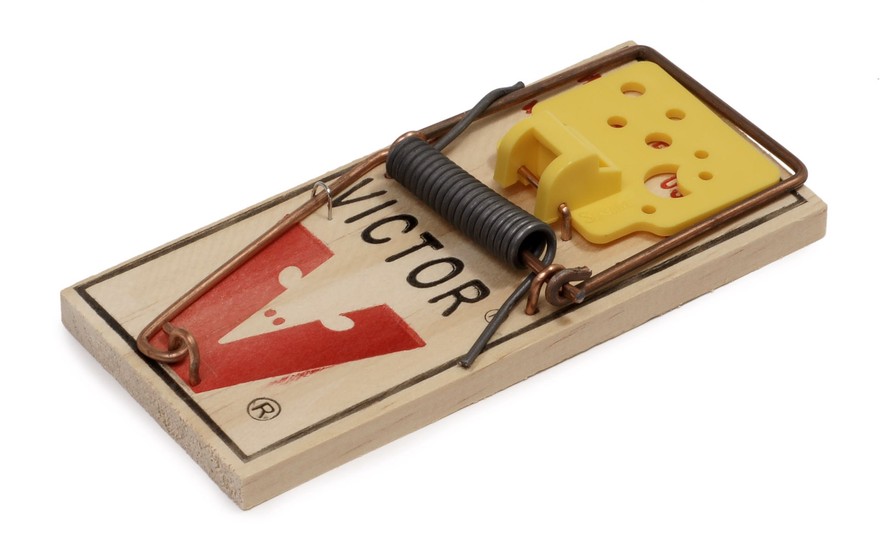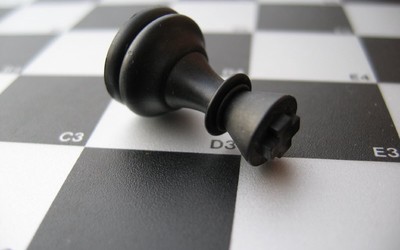
By Evan-Amos - Own work, Public Domain, https://commons.wikimedia.org/w/index.php?curid=11489714
Opening Tactics - Part 1: Good Traps -vs- Bad Traps
This is the first in a new series of blog posts on tactics in the opening. Today I will talk about traps and the question whether it is a good idea to play for traps or not. I will give you one example each for a bad trap, a mediocre trap and a good trap.Opening Tactics - Part 1: Good Traps -vs- Bad Traps
Introduction
Do you want to win your chess games very quickly, right in the opening?
If the answer is "YES!" then you are likely interested in traps, sharp opening tactics and tricks of all sorts.
This blog is written from the perspective of a player with a strong preference for OTB chess games with classical time controls and slow play. Personally I don't see much appeal in Blitz, Bullet let alone Hyper-Bullet. To each his own. I certainly don't mean disrespect to players who prefer these time controls.
What this blog is not about is typical Bullet tricks like "lefonging" or how to flag your opponent with the help of premoves.
Instead we will look at opening traps and opening tactics.
On an older German ChessBase DVD on opening traps, GM Matthias Wahls distinguishes traps by how good, how sound they are. While the selection he showed on his DVD was not of great relevance to my repertoire, I think he makes a good point, when he explains that some traps are better than others.
What I would like to add to that is, that what works well in Bullet or maybe even Blitz chess will not necessarily be playable in longer time controls and when I classify a trap as "good" or "bad", I am talking about classical time modes.
Traps & Unsound Gambits
The words "trap" and "gambit" sound exciting and full of promises of easy and quick victory.
Let's take a look at what these terms actually mean:
"A gambit (from ancient Italian gambetto, the act of tipping someone with the leg to make him fall) is a chess opening in which a player sacrifices material with the aim of achieving a subsequent positional advantage."
-- Edward R. Brace, An Illustrated Dictionary of Chess, Hamlyn, 1979
quoted in: https://en.wikipedia.org/wiki/Gambit
"Chess traps are moves which tempt a chess opponent to play a losing move. Traps are common in all phases of the game; in the opening, some traps have occurred often enough that they have acquired names."
https://en.wikipedia.org/wiki/List_of_chess_traps
Gambits can be more or less sound and even some of the theoretically not so correct ones will give good practical chances at club level, because of trappy lines that give the opponent plenty of room to go wrong.
The basic idea of most gambits is, to give up a pawn, sometimes more, to get an advantage in development, to get your pieces out quickly to very active squares, while the opponent lags behind.
Tactics in the Opening
Active and harmoniously developed pieces form the basis of all tactics in chess.
Personally I am not a big fan of the word "trap". I prefer to think and speak of "tactics in the opening", because that is what traps basically are.
One could say, that a trap is an opening tactic that is set up on the board in the explicit hope that ones opponent will miss it and make a mistake.
This is all okay and nice, as long as it is a move that is also good, when the opponent does not miss the tactic. In this case we have a good trap.
The problems begin, when a trap relies on the opponent to fall for it, but leaves the one playing it with a very bad position, should the opponent find - or know - the correct refutation. This is what I mean by "bad trap".
Mediocre traps are somewhere in between. They may not be the objectively best moves in the position, but at least they don't lead to a big disadvantage, should your opponent play the correct moves.
Should you play for Traps?
The decision is yours and yours alone.
Personally I recommend to study your openings and familiarize yourselves with the recurring tactical patterns. Pay special attention to miniature games, that were decided very quickly in the opening.
Make sure you are aware of potential dangers in the opening lines of your choice, so you don't end up falling into tactical pitfalls.
Also be aware of how to best punish your opponent, if he makes tactical mistakes.
Do not play for traps, especially bad ones, but do not shy away from complicated tactical opening lines that give both sides plenty of chances to go wrong.
Do not approach the game with the mindset that you have to win fast. You do not have to beat your opponent within the first twenty moves of the game. If you get the chance to do so, that's great, but if not, then be happy to play a game of chess and grind your way to victory in a long complicated endgame, if you have to.
The intention of trapping your opponent and the impatience of wanting to win ASAP, can often backfire.
I know, because I have gone down that road myself a couple of times.
Now let's look at a few examples of traps and tactics in the opening!
Practical Example 1: Bad Trap
This is a rare and not very well known opening trap, which I found in a YouTube video by Eric Rosen some time ago. It is a trap that was played in Hyper-Bullet games on Lichess by IM opperwezen a couple of times.
In the context of Hyper-Bullet or maybe even Bullet chess it is a good trap, in the sense that it scores very well. In classical time controls it would be a very bad trap obviously, bordering on outright nonsensical. As stated above, no disrespect meant to anybody!
It is just a question of where and when you use the trap. I strongly advise you not to try this in one of your OTB tournament games and I only showed it here to illustrate how much the value of a trap depends on the context it is played in.
Practical Example 2: Mediocre Trap
I have played this one myself a lot and with relatively good results too. Still, when my opponents knew what they were doing, I was not always happy with the position I had gotten myself into.
This trap comes in three stages. Nowadays this trap is very well known and you will even find the first two stages in a YouTube video from a lecture that was filmed by the Saint Louis Chess Club: Strategic Ideas for Beginners - WGM Jennifer Shahade - 2013.02.07 among many other videos and articles all over the internet.
Mediocre Trap - Stage 1: Kindergarten Chess
Stage 1 is really very simple and it is hard to imagine stronger players to fall for this. Yet, some 10-15 years ago I saw more than one 1800+ FIDE rated player lose to this trap.
You should always ask yourself, why your opponent just lets you have a pawn in the opening. Is it really for free? Once you actually think about it, this tactic is not too hard to spot.
Mediocre Trap - Stage 2: The Real Trap
Perhaps it is the basic simplicity of stage 1, that makes stage 2 so dangerous. Players who have seen and avoided the trap, may now tend to mentally relax, to pat themselves on the back. While they are still busy congratulating themselves on how much they were smarter than their opponent, they may blindly run into stage 2, which is really the same tactic as before, only slightly more sophisticated.
Now, if Black did not fall into either the first or the second stage of the trap, White can continue the game as a sharp gambit.
Mediocre Trap - Stage 3: The Gambit
This is known as the Sicilian Defense: Delayed Alapin, Basman-Palatnik Gambit.
Black can be up two, sometimes three pawns in material, but his king stays uncastled in the center and the only developed piece is his queen, so that gives White excellent practical chances.
The example game was played by yours truly with one of my previous accounts, PhayaNaga, on Lichess.
In my opinion this gambit is quite interesting and playable up to master level, as can also be seen by games from the database which I have inserted into the analysis above. Yet it does not seem like there are too many lines and variations which need studying. This one may be worth a try for some of you.
Practical Example 3: Good Trap
As stated above, a trap is good, if the moves also makes sense positionally and tactically even if the opponent makes no mistake. A perfect example of this is the Elephant Trap in the Queen's Gambit Declined.
Practical Example 4: Opening Tactics
Not all opening tactics are traps. This example game is an OTB game I played as Black back in 2013.
The move 11...Bc2 offers a bishop as sacrifice. My opponent afterwards told me, that he knew I wanted him to take it and that he would get punished for doing so, but he wanted me to show him how.
Had he not accepted the bishop, my position would still be great.
I consider this move one of the highlights of my chess career really. It is one that I am relatively proud of still, because I basically discovered this myself, based on a motif I had seen once or twice before in FM level games during long nights of burning midnight oil. Afterwards even my coach added this move to his repertoire database.
Practical Example 5: Exploiting Tactical Blunders
Sometimes we just have to play normal opening moves and recognize, when our opponents made a mistake. The sense of tactical alertness needed for this is mostly a matter of pattern recognition, knowledge of opening theory and most of all paying attention and thinking about what is going on on the board.
This is a very recent example game, that was played just two days ago in the Airthings Masters Preliminary 2022 rapid tournament that was broadcast here on Lichess.
It was GM Shakhriyar Mamedyarov who made the losing blunder on move 9 with the black pieces, allowing his opponent GM Andrey Esipenko a quick win.
I have included this game not only because it was very recent, but also to show you, that tactical blunders in the opening can happen even at the highest levels of play. Even if your opponent is a master, do not blindly trust his moves. Be attentive to the chance, that he may have made a mistake and if he did indeed, punish him!
What I find especially instructive about this game is, that Esipenko did not do anything special in the opening. He took no risks, did not play any unsound gambit lines or cheap tricks. He just developed his pieces normally and harmoniously, which is the foundation for all successful tactics in chess. When his world class opponent made a tactical mistake he spotted it and converted the advantage efficiently.
This is exactly the opening treatment I recommend to you as well!!
Note
You may be wondering, why I only published this first part in my series on opening tactics now, when later installments were published weeks ago already. The reason is, that I work on a number of different blog posts at the same time and publish them as they get finished. Since they don't have to be read in any particular order, this should not be a problem, I think.
As always, I hope you enjoyed the examples and maybe learned a thing or two.
Likes and constructive criticism are most welcome, of course!
More blog posts by Sefegiru

Played in Austria - Part 2
Three more games that were played in Austria. I hope you will enjoy them as much as I did!
Played in Austria - Part 1
In this series I will analyze games that were played in Austria. It will be a mixed bag of instructi…
Opening Tactics - Part 6: Strike When You Are Ready!
Fundamental opening principles dictate the need for quick, harmonious and efficient development of y…